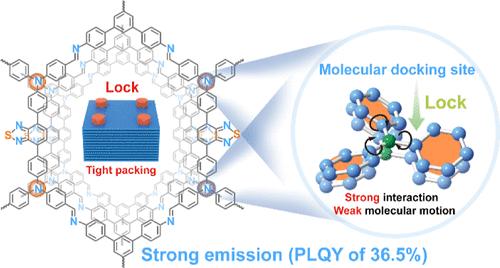双对接发光源与聚集诱导发光效应集成提高共价有机框架的亮度
IF 15.6
1区 化学
Q1 CHEMISTRY, MULTIDISCIPLINARY
引用次数: 0
摘要
大多数共价有机框架(COFs)表现出最小或弱发射,即使是用高发射的AIEgens构建。COFs中的荧光猝灭问题通常归因于分子运动或分子内电荷转移引起的非辐射衰变。因此,设计发射COF材料仍然是一项令人满意但具有挑战性的任务。在本研究中,我们提出了通过集成双对接光源构建高发射COFs的方法。机理研究表明,这种整合有效地限制了不希望的分子运动,减少了向亚胺键的电荷转移,从而增强了荧光的产生,提高了COFs的结晶度。一种基于苯并噻二嗪的COF (COF- dpqp - bt)具有显著的亮度和36.5%的光致发光量子产率,成功地用于小鼠脑血管的体内三光子荧光成像,成像深度约为1.2 mm。这项工作为发射型COFs的设计提供了有价值的见解。本文章由计算机程序翻译,如有差异,请以英文原文为准。

Boosting the Brightness of Covalent Organic Frameworks by Integration of Dual-Docking Luminogens with Aggregation-Induced Emission Effect
Most covalent organic frameworks (COFs) exhibit minimal or weak emission, even when constructed with highly emissive AIEgens. The fluorescence quenching issues in COFs are typically attributed to nonradiative decay induced by molecular motion or intramolecular charge transfer. As a result, designing emissive COF materials remains a desirable yet challenging task. In this study, we present the construction of highly emissive COFs through the integration of dual-docking AIEgens. Mechanism studies reveal that this integration effectively restricts undesired molecular motion and reduces charge transfer to the imine linkage, thereby enhancing fluorescence generation and improving the crystallinity of the COFs. One benzothiadiazide-based COF, COF-DPQP-BT, exhibits notable brightness with a photoluminescence quantum yield of 36.5% and is successfully utilized for in vivo three-photon fluorescence imaging of brain vasculature in mice, achieving an imaging depth of approximately 1.2 mm. This work provides valuable insights for the design of emissive COFs.
求助全文
通过发布文献求助,成功后即可免费获取论文全文。
去求助
来源期刊
CiteScore
24.40
自引率
6.00%
发文量
2398
审稿时长
1.6 months
期刊介绍:
The flagship journal of the American Chemical Society, known as the Journal of the American Chemical Society (JACS), has been a prestigious publication since its establishment in 1879. It holds a preeminent position in the field of chemistry and related interdisciplinary sciences. JACS is committed to disseminating cutting-edge research papers, covering a wide range of topics, and encompasses approximately 19,000 pages of Articles, Communications, and Perspectives annually. With a weekly publication frequency, JACS plays a vital role in advancing the field of chemistry by providing essential research.

 求助内容:
求助内容: 应助结果提醒方式:
应助结果提醒方式:


